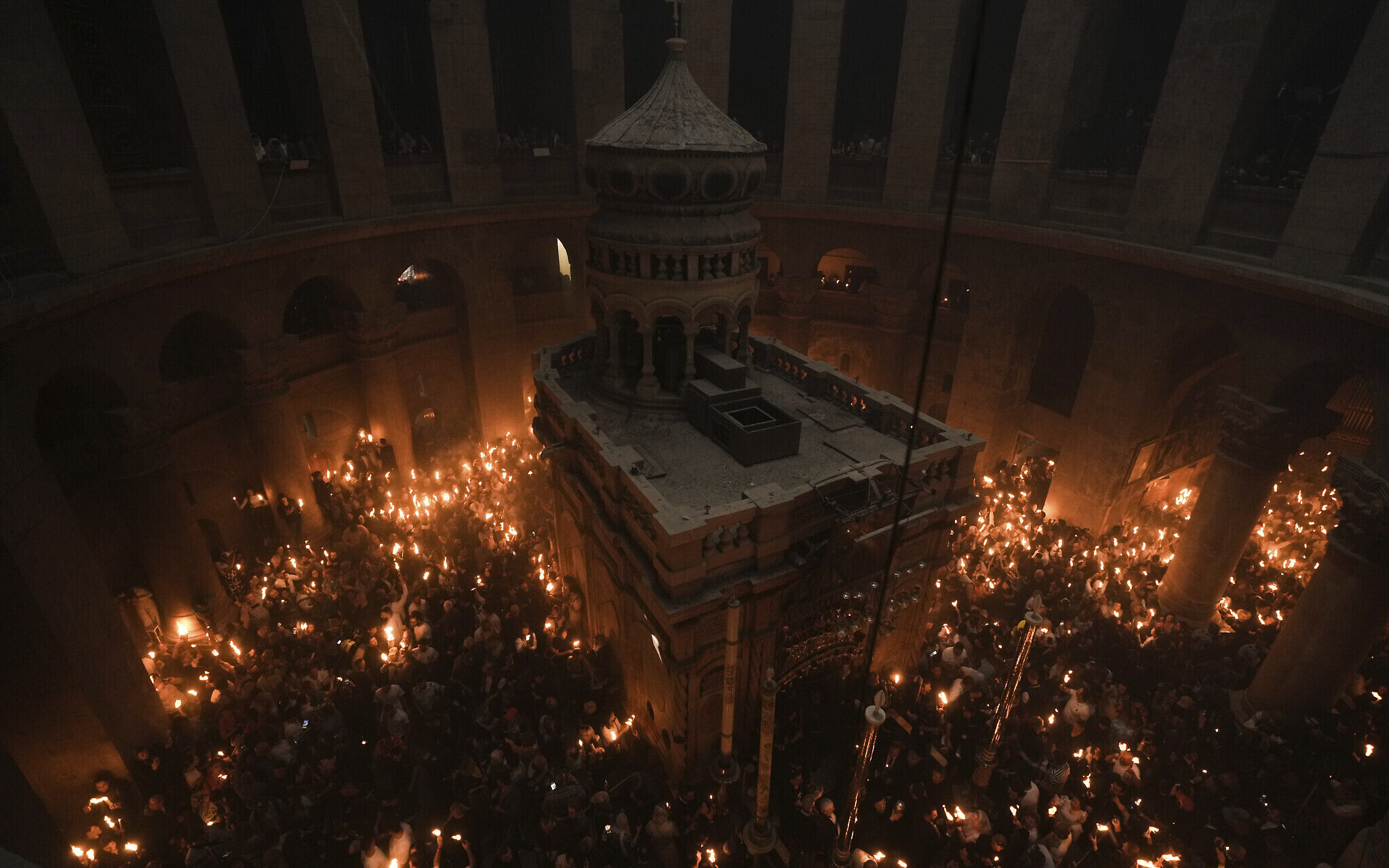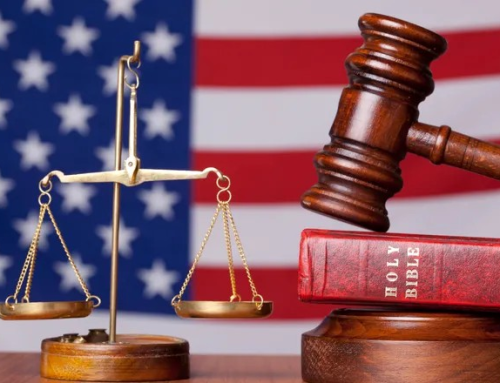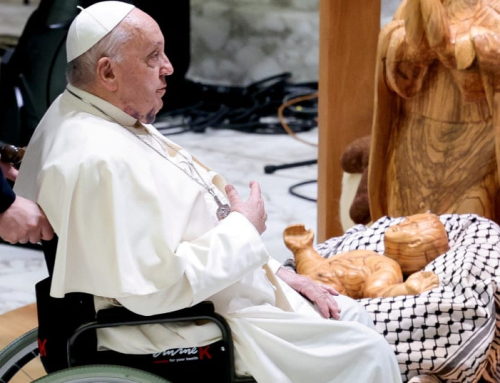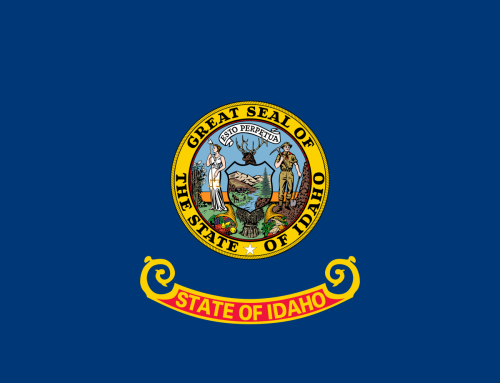Pilgrims angered that many not allowed to reach Church of the Holy Sepulchre for ancient ceremony; no injuries as worshipers break through barriers; police: limits are for safety
Christian worshippers thronged Jerusalem’s Old City and the Church of the Holy Sepulchre on Saturday to celebrate the ceremony of the “Holy Fire,” an ancient, mysterious ritual that has sparked tensions this year with the police and authorities.
In the annual ceremony that has persisted for over a millennium, a flame — kindled in some miraculous way in the heart of Jesus’ tomb — is used to light the candles of fervent believers in Greek Orthodox communities near and far.
On Saturday, after hours of frantic anticipation, a priest reached inside the dim tomb and ignited his candle. Each neighbor passed the light to another and, little by little, the darkened church was irradiated by tiny patches of light, which eventually illuminated the whole building.
Bells rang out. “Christ is risen!” the multilingual worshippers shouted. “He is risen indeed!”
Many trying to get to the church — built on the site where Christian tradition holds that Jesus was crucified, buried and resurrected — were thrilled to mark the pre-Easter rite in the city where it all started.
But for the second consecutive year, crowd size limits on event capacity dimmed some of the exuberance. While church leaders alleged earlier this week that Israel Police was unnecessarily infringing on Christians’ freedom of worship, a letter reviewed by The Times of Israel on Friday indicated that restrictions on the ceremony were imposed at the request of a Greek Orthodox official.
Angry pilgrims and clergy jostled to get through on Saturday while police struggled to hold them back, allowing only a trickle of ticketed visitors and local residents near the church.
Metal barricades sealed off alleys leading to the Christian Quarter. Over 2,000 police officers swarmed the stone ramparts.
Video circulating on social media apparently showed minor scuffles between police and worshipers trying to break through the barriers.
There were no reports of any injuries.
“It is sad for me that I cannot get to the church where my heart, my faith, wants me to be,” said 44-year-old Jelena Novakovic from Montenegro.
Israel has capped the ritual — normally an experience of being squeezed among multilingual, suffocating crowds — to just 1,800 people. Israel Police say they must be strict because they’re responsible for maintaining public safety.
In 1834, a stampede at the event claimed hundreds of lives. Two years ago, a crush at the Mount Meron Jewish holy site killed 45 people. Authorities say they’re determined to prevent a repeat of the tragedy.
In a statement released Thursday, police said the cap on crowd size was not their initiative. The force called the limitation a “necessary safety requirement” set by a safety engineer to prevent a potentially deadly stampede.
But Jerusalem’s Christian minority — mired in the Israeli-Palestinian conflict and caught between Jews and Muslims — say they fear Israel is using the extra security measures to alter their status in the Old City, providing access to Jews while limiting the number of Christian worshippers.
Israeli authorities and church officials have publicly quarreled over the crowd constraints for the past week. The Greek Orthodox patriarchate has lambasted the restrictions as a hindrance of religious freedom and called on all worshippers to flood the church despite Israeli warnings.
As early as 8 a.m., police were already turning back most worshippers from the gates of the Old City — including foreign tourists who flew from Europe and Palestinian Christians who traveled from across the West Bank — directing them to an overflow area with a livestream.
A few Palestinian teenagers from the neighborhood saw a chance to make a buck, promising tourists they’d get them into the church for some 200 shekels ($54) but leading them only to a nearby courtyard before asking for more money.
Ana Dumitrel, a Romanian pilgrim surrounded by police outside the Old City, said she came to pay tribute to her late mother, whose experience witnessing the holy fire in 1987 long inspired her.
“I wanted to tell my family, my children, that I was here as my mom was,” she said, straining to assess whether she had a chance.
The dispute comes as Christians in the Holy Land — including the head of the Roman Catholic church in the region as well as local Palestinians and Armenians — say that the most right-wing government in history has empowered Jewish extremists who have escalated their vandalism of religious property and harassment of clergy.
Israel says it’s committed to ensuring freedom of worship for Jews, Christians and Muslims and portrays itself as an island of tolerance in the Middle East.
The friction over Saturday’s Orthodox Easter ritual has been fueled in part by a rare convergence of holidays in Jerusalem’s bustling Old City. A few hundred meters away from the Church of the Holy Sepulchre, Muslims fasting for the 24th day of the holy month of Ramadan were gathering for midday prayers at the Al-Aqsa mosque, the third-holiest site in Islam. Earlier this week, tens of thousands of Jews flocked to the Western Wall for a mass prayer during the Passover holiday.
In the limestone passageways on Saturday, Christians pushed back by police were trying to cope with their disappointment. Cristina Maria, a 35-year-old who traveled from Romania to see the light kindled from the holy fire, said there was some consolation in the thought that the flame was symbolic, anyway.
“It’s the light of Christ,” she said, standing between an ice cream parlor and a dumpster in the Old City. “We can see it from here, there, anywhere.”
Original Source: https://www.timesofisrael.com/christians-flock-to-jerusalem-holy-fire-ritual-scuffles-with-police-over-crowd-size/







